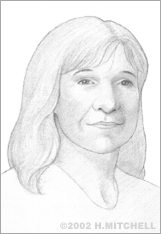Roberta Williams
In 1979, computer game innovator Roberta Williams was a housewife with two kids and no experience or particular interest in computers. Meanwhile, her husband, Ken, worked for a computer company on huge IBM mainframe machines. It was around that time that the Apple computer was becoming a popular item in people’s homes. Ken saw the potential home computing could have for the future and brought his enthusiasm home with him. That got Roberta interested in home computers. She began playing video games, first a text-based adventure game called Colossal Cave. Before long she was hooked on video games—especially of the adventure-style genre.
Williams began shopping around for more games that she could try and soon found there weren’t very many adventure-type games available. If this was all there was, she thought, then there was a need there, and she thought she might be the one who could fill it. That’s when she wrote and designed a murder mystery game called Mystery House.
Williams had no experience in gaming or computers – only in simple reading and storytelling. She did not know how to program computers, but her husband did. The pair worked on Mystery House together, creating an adventure game with black and white graphics for the Apple II computer. It was the first computer game ever that included graphics—predecessors had been text-only. To create graphics the Williams bought a machine called a Versawriter, which was basically a board of thick plexiglass that had an arm-like device with an electronic eye at the tip. The idea was that you put a piece of paper with a graphic on the Versawriter board and then you moved the arm around the outline of the graphic to “draw it” onto the computer. The hitch was, there was no existing software available for a computer to read the Versawriter. Ken wrote a program that served his and Roberta’s purposes. He also wrote a special language just for graphic adventure games called Sierra Creative Interpreter, or SCI. The language worked on any machine.
Once finished, the Williams put an ad for Mystery House in a computer magazine called Micro Magazine to see what interest it generated. The response was much more positive than they had expected—and was enough to inspire them to establish their own company, On-line Systems, to make more computer games. Eventually On-Line Systems moved its headquarters from Los Angeles to Oakhurst, California in the Sierra foothills. The Williams renamed the company Sierra On-Line and Roberta designed her second computer game, The Wizard and the Princess, which sold more than sixty thousand copies.
In 1983 Roberta began work on her most famous project, a game known as King's Quest. This game is said to have redefined the concept of adventure gaming. It allowed players to control a character on a two-dimensional platform and to have full control over the character’s movements. The character could also walk in front of, behind and around objects on the screen. King’s Quest would eventually become one of the most popular games of all time, inspiring seven sequels and three companion novels.
Williams went on to design many more successful games, including The Dark Crystal (1984), The Black Cauldron (1984), Mickey's Space Adventure (1984), Mixed-Up Mother Goose (1988), The Colonel's Bequest (1989), The Dagger of Amon Ra (1991) and Phantasmagoria (1995). She was subsequently approached with opportunities including making some games into Saturday morning cartoons, board games, and even feature films. In addition to creating some of the world’s most popular games, Williams was also said to be the first to make many of her games’ main characters female.


